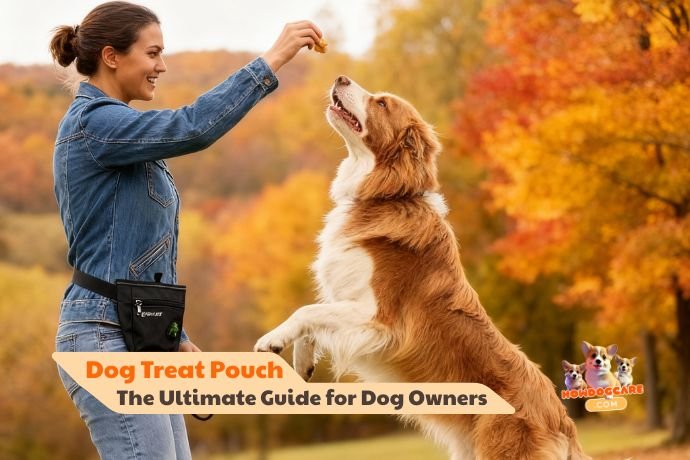Introduction to Dog Treat Pouches
What is a Dog Treat Pouch?
A dog treat pouch is a small, portable bag designed specifically for holding dog treats, making training sessions and daily walks more convenient. Unlike regular pockets, which can get messy with crumbs and grease, dog treat pouches are built to be easy to open, quick to access, and simple to clean. They often come with clips, belts, or straps so you can wear them around your waist, attach them to your belt, or even sling them over your shoulder.
Think of it as a tool belt for dog owners—just like a carpenter has a pouch for nails and tools, a pet parent has a pouch for treats. When you’re out walking your dog or running a training session, the last thing you want is to dig through your pockets or fumble with plastic bags. That’s where a dog treat pouch steps in as the ultimate helper.
Over the years, these pouches have evolved beyond just treat holders. Many now come with extra compartments for poop bags, toys, keys, and even your phone, turning them into mini storage hubs for dog outings. Whether you’re a professional trainer, a casual dog walker, or someone who loves outdoor adventures with their pup, a dog treat pouch can completely change the way you handle rewards and essentials on the go.
Why Every Dog Owner Needs One
If you’ve ever tried rewarding your dog quickly during training, you already know how important timing is. Dogs associate actions with rewards in just a few seconds, meaning if you’re late handing over the treat, they may not connect the behavior with the reward. A dog treat pouch solves this by keeping treats at your fingertips—literally one second away from rewarding good behavior.
Beyond training, think about the convenience. Instead of stuffing greasy treats into your jacket or struggling with crinkly treat bags, you can carry everything in one neat, organized pouch. Plus, it keeps your clothes clean and odor-free.
There’s also a safety angle. When you carry loose treats in your pocket, they can get crushed, stale, or even moldy if forgotten. A pouch with proper lining ensures freshness and hygiene. For those who walk dogs in busy areas, having quick access to treats can also help redirect attention when distractions (like squirrels or other dogs) appear.
Simply put, a dog treat pouch is more than an accessory—it’s a practical necessity for any dog owner who values convenience, cleanliness, and effective training.
Benefits of Using a Dog Treat Pouch
Hands-Free Convenience
Imagine juggling a leash, poop bags, your phone, and a water bottle—all while trying to sneak a treat from your pocket. Sounds stressful, right? A dog treat pouch eliminates this hassle by freeing up your hands. Many designs feature adjustable waist belts or shoulder straps, so you don’t have to worry about carrying extra bags. This makes it ideal for hikes, jogs, or even casual park strolls where you need both hands for other tasks.
Hands-free convenience is especially useful for owners with energetic or large dogs who require firm handling. When your hands are free, you can better manage your dog’s leash, react to sudden pulls, or even guide them during agility training without fumbling for rewards. It’s like upgrading from an overloaded handbag to a sleek crossbody bag—you feel lighter, more organized, and in control.
Improved Training Efficiency
The biggest advantage of using a dog treat pouch is the role it plays in effective training. Dog training is all about timing and consistency. With a pouch, you can deliver treats instantly after a correct behavior, reinforcing positive actions much more effectively.
For example, if you’re teaching your dog to “sit,” you need to reward them the second their bottom touches the ground. If you’re busy fishing in your pocket, the moment passes, and the dog may not understand what behavior earned the treat. A pouch solves this timing issue perfectly.
Professional trainers swear by them because they allow for repetition and rhythm during training sessions. Instead of breaking flow to grab treats, you maintain smooth interactions, keeping your dog focused and motivated. In fact, studies show that dogs trained with immediate rewards learn up to 30% faster than those with delayed reinforcement.
Storage for Essentials
Today’s dog treat pouches go beyond just holding snacks. Many come with zippered compartments or mesh pockets where you can store poop bags, car keys, ID cards, or even small toys. Some high-end versions even have space for collapsible water bowls.
This all-in-one functionality means you don’t need to carry an extra bag every time you take your dog out. Everything you need—treats, bags, phone, and keys—can be organized in one place. For busy pet parents, this simplicity is a game-changer.
Types of Dog Treat Pouches
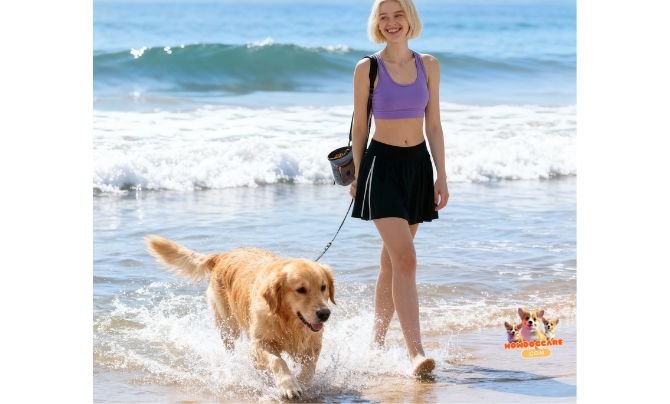
Basic Dog Treat Pouches
Basic pouches are simple, no-frills bags designed solely to hold treats. They’re usually small, lightweight, and budget-friendly. These are perfect for dog owners who just need a quick way to access treats during a walk or training session without worrying about extra features. Most of them clip directly onto your belt or waistband for convenience.
While they don’t offer fancy compartments, basic pouches are durable, affordable, and practical. If you’re new to using a pouch, starting with a basic model is often the best option.
Multi-Functional Training Pouches
These are the Swiss Army knives of dog treat pouches. They come with multiple compartments, waterproof linings, and sometimes even built-in dispensers for poop bags. Many professional trainers and serious dog owners prefer these because they combine functionality with organization.
Multi-functional pouches often have larger storage capacity, making them ideal for long training sessions or outdoor adventures. Some models even include reflective strips for night safety, which is a big plus for evening walkers.
Stylish and Fashionable Options
Who says functional gear can’t look good? In recent years, manufacturers have started designing treat pouches that resemble fashionable handbags or waist packs. These are perfect for urban dog owners who want practicality without sacrificing style.
With options available in leather, canvas, or trendy colors, these pouches let you match your pet accessories with your personal fashion sense. They might cost more than basic pouches, but they prove that dog gear can be chic.
Features to Look for in a Dog Treat Pouch
Material and Durability
When shopping for a dog treat pouch, material is everything. Nylon and polyester are common choices because they’re lightweight, water-resistant, and durable. Some premium pouches are made with reinforced fabrics that can withstand tugging, scratching, and regular outdoor use.
You’ll also want to check the lining. A waterproof or grease-resistant lining makes cleaning easier and prevents oils from seeping into the fabric. For dog owners who train daily, durability is key—you don’t want a pouch that wears out after a month of use.
Size and Capacity
Size matters when it comes to treat pouches. Too small, and you’ll constantly run out of treats mid-training. Too large, and it becomes bulky and uncomfortable. The right size depends on your dog’s breed and the length of your sessions.
For small breeds, a compact pouch may be enough. For larger dogs or multi-dog households, a bigger pouch with multiple compartments is better. Some models even allow you to adjust the capacity with expandable pockets, giving you flexibility.
Accessibility and Opening Mechanisms
Speed is critical when rewarding your dog. That’s why the opening design of a pouch is so important. Magnetic closures, drawstring tops, or spring-loaded openings allow for one-handed access, which is ideal during training. Velcro is common but can be noisy, sometimes distracting dogs during sessions.
The best pouches combine security with quick access. You don’t want treats spilling everywhere, but you also don’t want to wrestle with zippers while your dog waits for a reward.
Cleaning and Maintenance
Let’s be honest—treats can get messy. Crumbs, grease, and even bits of cheese or meat can leave residue inside your pouch. That’s why choosing one that’s easy to clean is essential.
Some models are machine-washable, while others have removable inner liners you can rinse after each use. If you often use moist or oily treats, a pouch with a waterproof lining will save you a lot of headaches. A clean pouch not only looks better but also prevents bacteria and odors from building up.
How to Use a Dog Treat Pouch Effectively
Timing Rewards for Training
Timing is everything in dog training. A treat pouch helps you reward your dog instantly, which strengthens the connection between action and reward. For example, if your dog learns to “stay,” you can quickly deliver a treat as soon as they hold the position. This immediate feedback teaches them faster and keeps them motivated.
Think of it like a teacher handing out gold stars. If the star comes days later, it means nothing. But if it’s given immediately after good work, it reinforces the behavior. Dogs are no different—they thrive on quick recognition.
Balancing Treat Portions
Using a pouch doesn’t mean stuffing it full of treats without control. You still need to balance portions carefully. Overfeeding can lead to weight gain and health problems. A smart way to use the pouch is to pre-measure treats before you leave the house. That way, you know exactly how much your dog is getting.
Some trainers also recommend mixing high-value treats (like cheese or chicken) with lower-value ones (like kibble) inside the pouch. This keeps your dog guessing and excited since they never know which treat is coming next.
Combining with Clicker Training
For those who practice clicker training, a pouch is practically a must-have. The click marks the exact behavior, and the treat reinforces it. With a pouch, you can hold the clicker in one hand and grab a treat instantly with the other, making the process seamless.
Without a pouch, fumbling for treats can throw off timing and confuse your dog. With it, you create a smooth, consistent system that speeds up learning and keeps your sessions enjoyable.
Best Dog Treat Pouches on the Market (2026 Edition)
Budget-Friendly Options
Not everyone wants to spend big bucks on a treat pouch, especially if you’re new to training or only go on casual walks. Luckily, the market is full of affordable yet practical choices. Budget-friendly dog treat pouches typically feature a simple design with one main compartment, a clip, or a belt loop for attachment.
These models may not have all the bells and whistles of premium versions, but they do the job. Many are made from nylon or polyester, which are lightweight and easy to clean. Some even include a small side pocket for poop bags or keys.
The key benefit here is accessibility. Even low-cost models often come with quick-draw openings, making it easy to grab treats on the go. If you’re unsure whether you’ll enjoy using a pouch long-term, starting with a budget model is the perfect way to test it out. You’ll be surprised how much convenience a simple $10–$15 pouch can bring to your training sessions.
1. Outward Hound Treat Tote Hands-Free Dog Training Pouch
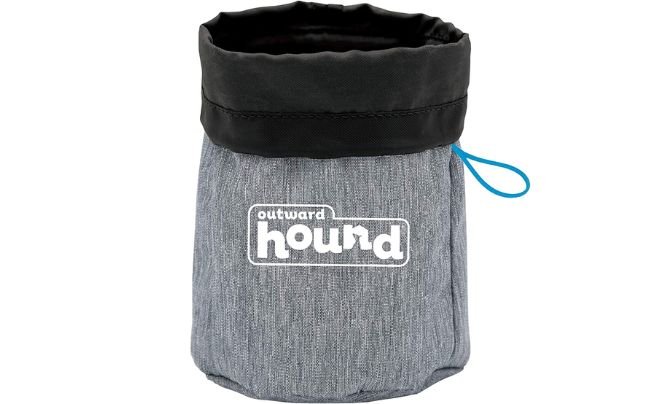
A compact and lightweight pouch designed for easy access. It’s ideal for casual walks and basic training sessions.
Pros
- Very affordable and beginner-friendly
- Compact design for hands-free use
- Durable nylon material
- Simple drawstring closure
Cons
- Limited storage capacity
- No extra compartments for phone or keys
- Basic design without premium features
2. Gobeigo Dog Treat Pouch and Training Clicker
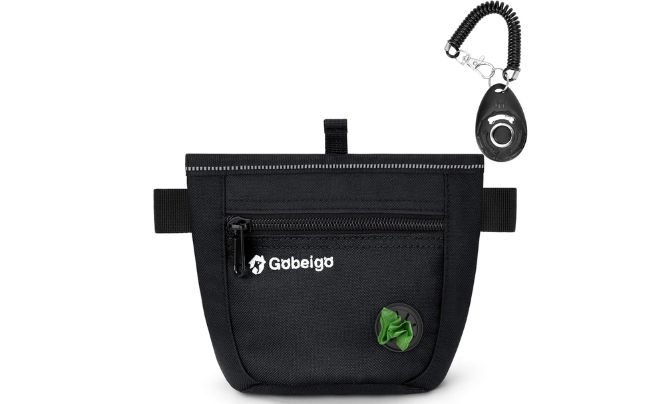
A versatile option with dual magnetic closures to prevent spills, plus extra storage for essentials.
Pros
- Two strong magnetic closures for no spills
- Large 2-cup capacity
- Built-in poop bag dispenser
- Includes waist belt and metal clip for flexibility
Cons
- Slightly bulkier than basic pouches
- More features mean a higher learning curve
- Not the most stylish option
3. PetSafe Mini Treat Pouch
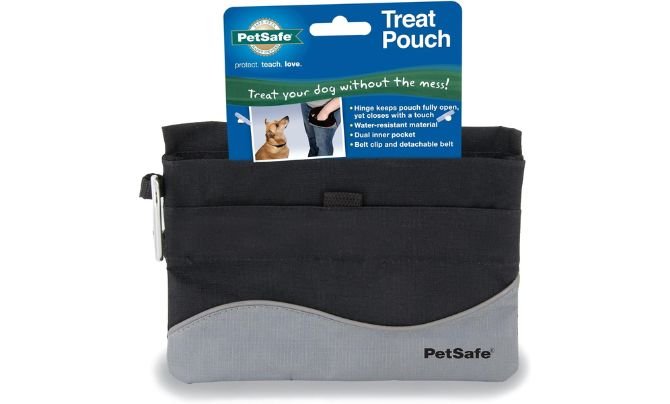
Compact yet practical, this pouch is waterproof and includes extra storage for small essentials.
Pros
- Waterproof design keeps treats fresh
- Dual inner pocket and front storage pocket
- Compact and discreet size
- Adjustable fit for comfort
Cons
- Limited storage capacity
- Not suitable for long training sessions
- Basic closure mechanism compared to premium models
Premium High-End Choices
For professional trainers or serious dog owners, premium treat pouches are worth every penny. These high-end models are designed with durability, comfort, and extra features in mind. Think heavy-duty zippers, waterproof linings, multiple compartments, and adjustable straps for a custom fit.
Some even have magnetic closures for lightning-fast access, plus hidden pockets for valuables like your phone, money, or cards. High-end pouches often include a built-in poop bag dispenser, making them all-in-one training and walking companions.
The difference becomes clear during extended training sessions. While a budget pouch may wear out quickly, a premium one is built to last years. They’re also usually more comfortable to wear for long periods thanks to padded waistbands or ergonomic straps. If you train multiple dogs or spend hours outdoors daily, investing in a premium pouch can save you frustration in the long run.
1. Ruffwear Treat Trader Dog Treat Pouch
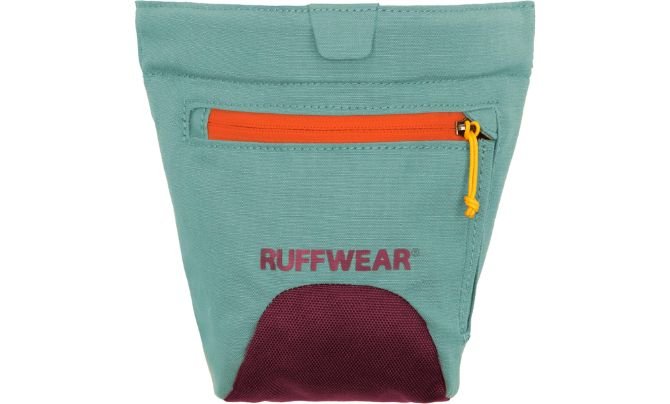
A professional-grade pouch with magnetic closure, waterproof lining, and a sleek design for serious trainers.
Pros
- Durable, weather-resistant materials
- One-handed magnetic closure
- Food-grade waterproof lining
- Zippered pocket and clicker loop
Cons
- Expensive compared to budget options
- Smaller storage than some bulky models
- No built-in poop bag dispenser
2. Hurtta ECO Dog Treat Pocket
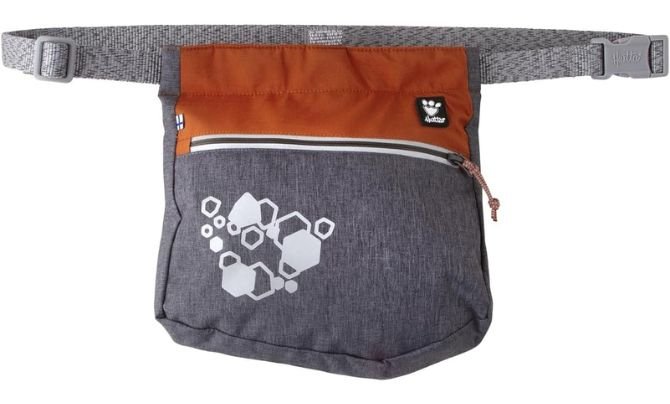
Stylish and eco-conscious, this premium pouch combines functionality with sustainable materials.
Pros
- Made with eco-friendly recycled materials
- Large capacity suitable for long sessions
- Durable construction for daily use
- Stylish design with modern look
Cons
- Premium price point
- Limited availability in some regions
- No extra compartments for valuables
3. EzyDog SnakPak Pro Wearable Dog Treat Bag
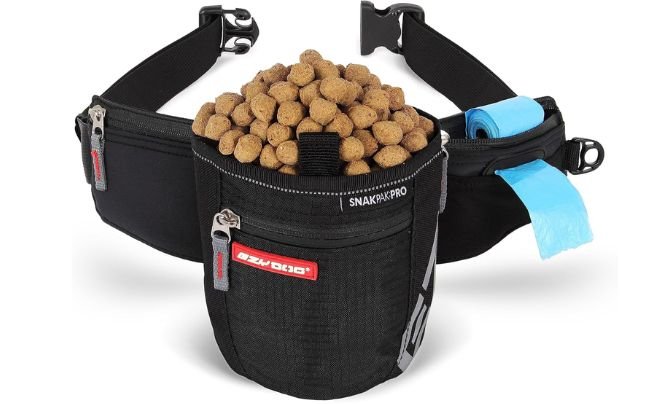
A rugged, waterproof pouch with professional features, including a poop bag dispenser and multiple carry options.
Pros
- Waterproof and durable construction
- Built-in poop bag dispenser
- Magnetic closure for easy access
- Multiple wearing styles (belt or waist pack)
Cons
- Higher cost than budget pouches
- Slightly heavier than minimalist designs
- Bulkier for casual short walks
Eco-Friendly Dog Treat Pouches
Eco-conscious dog owners are driving a new trend—sustainable dog treat pouches. These are made from recycled materials, organic fabrics, or biodegradable components. Some brands now use recycled plastic bottles to create durable, eco-friendly fabrics that perform just as well as synthetic ones.
Aside from reducing your environmental footprint, eco-friendly pouches often come with minimalist designs and natural colors. They may also avoid harsh chemicals in their waterproof linings, making them safer for both dogs and humans.
If sustainability matters to you, keep an eye out for pouches labeled with certifications like GRS (Global Recycled Standard) or OEKO-TEX, which guarantee eco-responsible production. Not only are you helping the planet, but you’re also setting a great example for other pet owners.
1. OllyDog Goodie Treat Bag
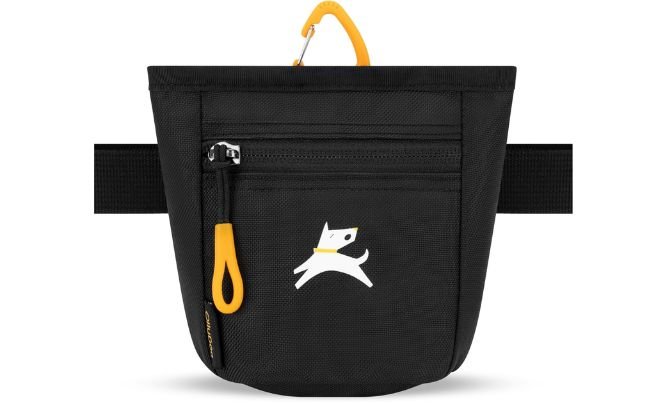
Made with eco-conscious materials, this pouch offers a stylish design and hands-free wear options.
Pros
- Made from recycled eco-friendly materials
- Three ways to wear for flexibility
- Magnetic closure for no-spill use
- Compact yet practical size
Cons
- Not as spacious as premium pouches
- No dedicated zippered pocket
- Limited color range
2. Mighty Paw Dog Treat Pouch
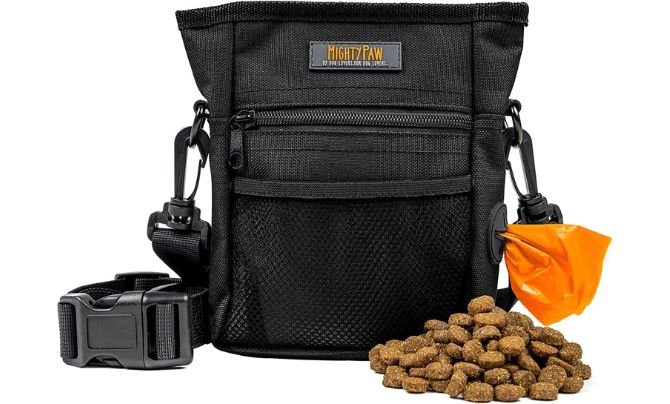
A practical eco-friendly choice with magnetic clasp and a built-in poop bag holder.
Pros
- Eco-conscious design with durable build
- No-spill magnetic clasp
- Includes poop bag dispenser
- Hands-free carrying options
Cons
- Moderate capacity, not ideal for long hikes
- Slightly more expensive than budget options
- Minimal extra compartments
3. Dog Treat Pouch with Training Clicker (Silicone, 1.67 Cup)
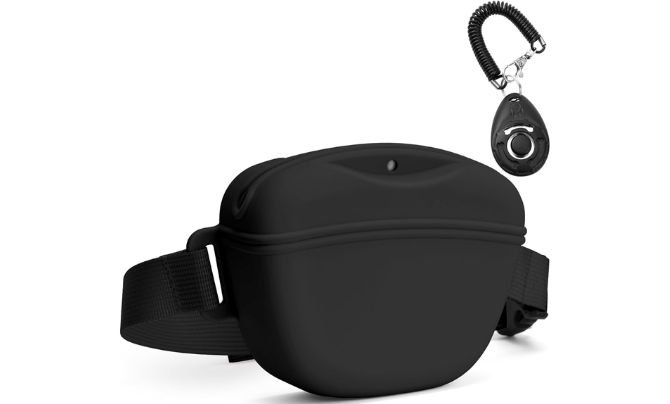
This silicone pouch is durable, spill-proof, and includes a training clicker for added value.
Pros
- Strong magnetic closure prevents spills
- Durable silicone design for easy cleaning
- Includes training clicker
- Compact and lightweight
Cons
- Smaller storage capacity
- No extra pockets for accessories
- Silicone may attract dust and dirt
DIY Dog Treat Pouches
Homemade Fabric Pouches
If you’re crafty, making your own dog treat pouch can be a fun and cost-effective project. All you need is some sturdy fabric (like canvas or denim), a drawstring or zipper, and basic sewing skills. Homemade pouches can be customized to fit your exact needs—whether that’s a compact size for short walks or a larger one for training sessions.
The best part about DIY is personalization. You can choose fabrics with fun patterns, add your dog’s name, or even design it to match your leash and collar set. Plus, when you make it yourself, you control the durability and functionality. Want an extra pocket? Just sew one in.
DIY fabric pouches are not only practical but also eco-friendly since you can upcycle old materials. For example, an old pair of jeans can easily be repurposed into a durable, stylish treat pouch. It’s a creative way to save money while still enjoying the convenience of a pouch.
Upcycling Old Bags into Pouches
Another DIY option is repurposing old bags. Have a fanny pack you never use? Or maybe a small crossbody bag collecting dust in your closet? With a little modification, these can become excellent treat pouches.
All you really need to do is clean them out, line them with washable material (like a reusable snack bag), and maybe add a clip or strap for convenience. Some dog owners even convert old climbing chalk bags or camera lens pouches into treat holders since they’re already designed for easy access.
Upcycling is not only budget-friendly but also sustainable. Instead of buying something new, you give new life to items you already own. Plus, it adds a unique flair—you won’t find anyone else at the dog park with the same treat pouch as you.
Choosing the Right Dog Treat Pouch for Your Lifestyle
For Professional Trainers
Professional dog trainers often require pouches that can keep up with long hours and multiple dogs. A high-capacity pouch with several compartments is usually the best choice. Trainers need durability, quick access, and comfort since they wear their pouches daily.
Some trainers also prefer models with dual compartments, allowing them to carry different types of treats (like high-value and low-value rewards) at the same time. This flexibility makes training more effective and dynamic.
If you’re training dogs professionally, it’s worth investing in a premium model that won’t let you down. Look for pouches with reinforced stitching, waterproof linings, and ergonomic designs to prevent discomfort during long sessions.
For Casual Walks and Outings
If you’re just heading to the park or strolling around the neighborhood, a compact, lightweight pouch is all you need. Casual dog owners often prefer smaller pouches that clip onto their waistband or slip onto a belt.
These are usually inexpensive, easy to carry, and perfect for holding just enough treats for short outings. Some even come with built-in poop bag holders, which adds to the convenience without weighing you down.
For this lifestyle, comfort and simplicity are more important than advanced features. You don’t need to overcomplicate things—just pick a pouch that feels easy to wear and holds enough treats for a half-hour walk.
For Outdoor Adventures
Do you take your dog hiking, camping, or on long runs? Then you’ll want a pouch designed for rugged use. Outdoor-friendly models are usually water-resistant, dustproof, and equipped with extra storage for essentials like collapsible bowls or energy snacks for your pup.
Some adventure-ready pouches are integrated into harness systems or come with detachable straps so you can wear them crossbody or on your waist. Reflective strips are another useful feature for those who enjoy evening hikes.
If you and your dog are always exploring the outdoors, investing in a weather-resistant pouch will save you headaches and keep your adventures stress-free.
Related Articles
Dog Treat Pouch Safety Tips
Keeping Treats Fresh and Safe
Dog treats, especially soft or moist ones, can spoil quickly if not stored properly. A good pouch should have a lining that keeps treats fresh while preventing oils and crumbs from leaking out. Some models even include zippered compartments or silicone liners that act as mini airtight containers.
To keep treats safe, avoid leaving them in the pouch overnight. Instead, empty it after each walk or training session and wash it if needed. Not only does this keep treats fresh, but it also prevents mold and bacteria from building up.
Avoiding Overfeeding
A treat pouch makes it easy to hand out rewards—but it also makes it easy to overdo it. Too many treats can lead to obesity, digestive problems, or nutritional imbalances. To avoid this, pre-portion your treats before heading out.
For example, decide on 20 small training treats and stick to that amount. This keeps you accountable and ensures your dog doesn’t end up eating half their daily calories in one session.
Another helpful tip is mixing regular kibble with high-value treats. This way, your dog still gets rewarded frequently, but not every reward is calorie-heavy.
Secure Fastening to Prevent Loss
One common issue with treat pouches is accidental spills. If your pouch doesn’t close securely, you risk losing treats (and attracting every dog at the park). To avoid this, choose a pouch with a reliable closure system—magnetic flaps, drawstrings, or zippers work best.
Also, make sure the attachment system is strong. A flimsy clip can snap off, leaving your pouch (and all your treats) behind. For peace of mind, many owners prefer pouches with adjustable waistbands or carabiner clips that lock securely in place.
Cleaning and Maintaining Your Dog Treat Pouch
Machine Washable vs. Hand Wash Only
One of the biggest differences between treat pouches is whether they’re machine washable. Machine-washable pouches are incredibly convenient—just toss them in with your laundry, and they come out clean. These are perfect if you frequently use moist, crumbly, or oily treats.
Hand-wash-only models usually have sturdier materials or special coatings that might not hold up in a washing machine. While they may take a bit more effort to clean, they often last longer and resist wear and tear better.
Preventing Odor Build-Up
Let’s face it—dog treats can stink, especially when left in a pouch for too long. To prevent odors, make it a habit to empty your pouch after every use. Rinse out crumbs, wipe down the lining, and let it air dry completely before storing it.
Some pouches even come with removable liners that you can wash separately, which makes cleaning a breeze. If your pouch does develop an odor, a quick soak in a vinegar-water solution can help neutralize it.
Regular maintenance not only keeps your pouch smelling fresh but also extends its lifespan, ensuring you get the most value out of your purchase.
The Role of Dog Treat Pouches in Positive Reinforcement Training
Why Treats Work Best as Rewards
Positive reinforcement is one of the most effective dog training methods, and treats play a central role in it. Dogs are motivated by food—it’s immediate, tangible, and highly rewarding. When you pair a desired behavior with a tasty treat, your dog quickly learns to repeat that behavior.
Think about it from the dog’s perspective: if sitting politely gets them a piece of chicken, they’ll be eager to sit again. Unlike toys or praise, which may not appeal to all dogs, treats almost always work because they trigger a natural response.
This is where a dog treat pouch becomes essential. If you can’t deliver the reward quickly, the training loses effectiveness. Dogs live in the moment, so the reward needs to follow the action immediately. A pouch keeps treats ready at all times, ensuring perfect timing. Without it, you’d be fumbling in your pockets or reaching into a noisy bag, losing that golden training window.
How Pouches Make Training Easier
Training requires consistency and repetition, and a pouch makes this easier by streamlining the process. With one hand on the leash and the other free to grab treats instantly, you can maintain focus and control.
Consider clicker training, for example. You click to mark the behavior, then immediately reach for a treat. With a pouch, the motion becomes seamless—you don’t break rhythm, and your dog stays engaged.
Another way pouches help is by encouraging reward variety. Some trainers carry different types of treats—kibble, soft chews, and high-value rewards like cheese. A multi-compartment pouch allows you to switch rewards based on the difficulty of the task. Simple commands might earn kibble, while more challenging behaviors get something extra delicious.
The convenience of a pouch also makes it easier to practice training outside your home. Whether you’re at the park, a busy street, or even a dog-friendly café, your pouch ensures you’re always ready to reinforce good behavior.
Alternatives to Dog Treat Pouches
Treat Bags with Belt Clips
One alternative to a traditional treat pouch is a simple treat bag with a belt clip. These are usually smaller, more minimalist, and attach directly to your waistband or belt. They’re perfect for short outings or owners who don’t want to carry a full pouch.
While they don’t offer much storage space, they’re extremely lightweight and affordable. Many come with magnetic or Velcro closures for quick access. The downside? Limited capacity and fewer compartments for extras like poop bags or keys. Still, for quick training sessions, a treat bag with a clip might be all you need.
Treat Dispensing Toys
Another alternative is a treat-dispensing toy. These aren’t meant to replace pouches during training, but they do provide enrichment and mental stimulation for your dog. Toys like Kongs or puzzle feeders release treats as your dog interacts with them, rewarding persistence and problem-solving.
These are especially useful when you want to keep your dog entertained at home or reduce anxiety when left alone. However, they don’t provide the instant reward timing necessary for training commands. That’s why they’re more of a supplement than a replacement for treat pouches.
In short, while alternatives exist, nothing matches the convenience and precision of a dedicated dog treat pouch for training purposes.
Conclusion
A dog treat pouch might seem like a small accessory, but for dog owners, it can make a huge difference. From keeping your hands free to ensuring quick reward timing during training, it’s one of the most practical tools you can own. Whether you choose a budget-friendly model, a premium trainer’s pouch, or even a DIY version, the key is finding one that fits your lifestyle.
Remember, training is all about timing, consistency, and motivation. A pouch keeps you prepared, organized, and ready to reinforce good behavior instantly. For casual walks, outdoor adventures, or professional training sessions, it’s more than just a bag—it’s a game-changer in building a stronger bond with your dog.
So next time you head out with your pup, clip on that pouch and see how much smoother your walk or training session becomes. You’ll quickly realize it’s not just a convenience—it’s an essential part of being a dog parent.
FAQs
Can I use human snack bags as a dog treat pouch?
Yes, reusable human snack bags can work as temporary pouches, but they may not be as durable or convenient as purpose-built options. They’re great for DIY solutions, though.
Do all pouches come with poop bag dispensers?
Not all, but many modern models include them. If this feature matters to you, check the product description before buying.
What’s the best pouch for wet treats like cheese or hot dogs?
Look for one with a waterproof or silicone lining. Some pouches even come with removable inner bags designed specifically for moist treats.
Can treat pouches help with leash pulling?
Yes. Quick rewards for walking nicely on a loose leash are easier with a pouch. The instant reinforcement helps reduce pulling behavior.
Do dogs ever get too dependent on treat pouches?
Not really. Dogs don’t care where the treat comes from, just that it comes quickly. Over time, you can reduce treat frequency, but the pouch remains a handy training tool.


